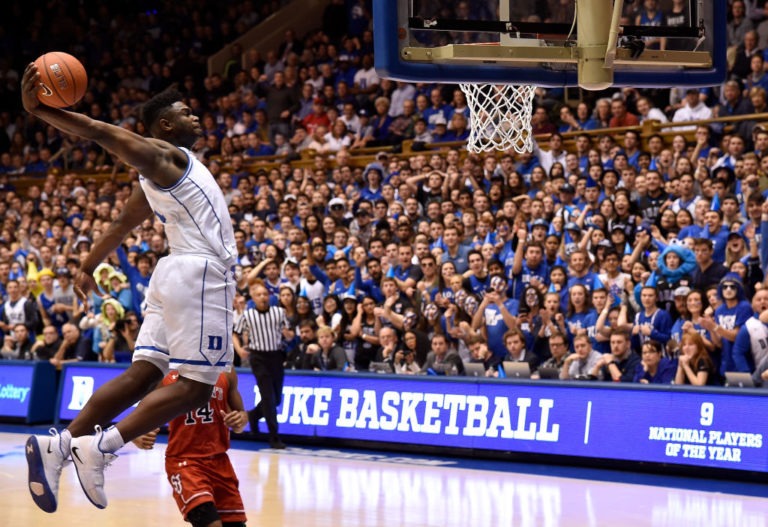We're still going to go a long time without sucking the NBA, which means spending another good time without enjoying who, finally, had become one of its main attractions and distractions: Zion Williamson. 'The restrained Zion Williamson', which I prefer to call it here; because there is one good fact and another even better:
The first, that the rookie, still overwhelmed by the wave of hyping, is not disappointing. But not at all. Since their entry into the rotation at the end of January, the Pelicans are different (they are in fact, neither more nor less, what was expected of them at the dawn of October), and they are going like crazy in the hunt for the eighth place in provisional power of the Memphis Grizzlies and Ja Morant, whose ROY He is in slight (and not so slight) danger of losing it if his team previously loses its ticket to the playoffs (if there are any, of course).
The second piece of information and the one that adds the most value: that it is being controlled. Who plays trán-trán and under the radar. That after the frustrating injury that forced him to postpone his debut for almost four months, already fully immersed in the month of March, destroyer Duke avoided stepping on the red stripe of the rev counter. In other words, the bug already masters parquet and methacrylate, and it doesn't even need to play with all the power that the bug keeps inside.
And yet, because he is careless, in one of these he hits his head against the rim.
Hanging in the air is like us touching our faces during a pandemic: it happens on its own. He, on medical advice, keeps his springs at bay to avoid an unnecessary overload on his already strained chassis, with the 130 kilos of lean mass that, from dawn to bed, he drags with him.
The 'ordinary' people
But let's start where it belongs: at the beginning. The Zion case can wait. 'Jumps', He said: where, how much y why.
Among those of us who don't get a penny for jumping more than the rest (most of you who read me, I suppose), our averages by age in terms of vertical jumping power (starting from a static position), according to data collated by the portal Home Exercise Equipment Central In 2019, they are the following:
- 18 to 20 years: 19,5 inches.
- 20 to 29 years: 20 inches
- 30 to 39 years: 17 inches.
- 40 to 49 years: 14 inches.
- 50 to 59 years: 11 inches.
Evaluating (in a range of 'Poor' to 'Excellent') as follows:
- Excellent: more than 28.
- Very good: from 24 to 28.
- Above average: 20 to 24.
- Average: 16 to 20.
- Below average: 12 to 16.
- Poor: less than 12.
Knowing that 1 inch = 2,54 cm, let's stay with the couplet of the first of the brands; the 'excellent' of an average male: +28 inches (+71,12 cm).
Now let's change boats and get on board the one with the professionals. The elite athletes. And within this we are going to focus on two of the ball sports of the major leagues of North America. American football and basketball; or its translation into acronyms: NBA and NFL.
Comparative jump: NBA AND NFL
There are two categories of jumping with their own name (in English) on which we are going to focus:
- Standing Vertical
- Vertical Running
The SVertical tanding (SV)—also known as Sargent Jump due to its martial nature—it is the jump pure and simple, without sweetening. Springs put to the test without any added impulse than what their owners can project when pushing, statically, against the ground.
And in this district, the dominance of the NFL over the NBA is devastating:
- NFL SV Record: 48 inches (116,86 cm). Work by Gerald Sensabaugh in 2005.
- NBA SV Record: 36 inches (96,52 cm). Two signatories: Dwayne Mitchell and Justin Anderson in 2012 and 2015 respectively.
In the absence of image content of Sensabaugh's record, in the video below we have, to get an idea of the antigravity waver, Bryon Jones and his mark of 44,5 inches at the 2015 NFL Combine. He is considered the best jumper in the history of American football, but due more to its broad jump (jump forward) than to its vertical.
Why do they have a better vertical jump in the NFL than in the NBA?
This reality, perhaps for some, is surprising and even difficult to assimilate at the outset, taking into account the highlights of prodigious dunks that we are so accustomed to seeing, and with an increasing number of players caressing the circumference of the rim with the tip of their nose.
So, those eight inches of advantage in the NFL… for what reason? Well, I bring you an argument based on three reasons.
Basketball players don't actually have the need to jump that high. The hoop is ten feet high (3,05 meters), so for a 6-foot player (1,83 meters... that is, a 'short' guy) an elevation of 33-34 inches is enough (something more if you want to nail a good plug) to achieve your objective: sink it downwards.
But in addition, 99% of dunks are preceded by a certain run, no matter how minimal, which makes it even easier to gain jumping power.
Secondly, the demands of one sport and another. The main characteristic that the NFL demands to survive at the top (and saving cases in the NBA like those of Westbrook, LeBron, Nurkic or old Rose), is explosiveness. And that is what they care about most about crushing both on the grass and in the gym.
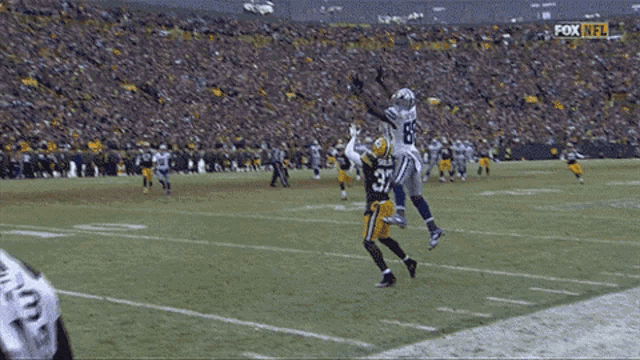
Finally, the pace of the league and the games themselves. The NBA season is like baiting geese to obtain the desired foie gras: swallow until it hurts; 82 games in six months with almost no rest and matches divided into 4 quarters of 12 minutes, implies giving greater weight to resistance over power.
Meanwhile, in the NFL, in addition to much healthier schedules, the sum of points on the field of play is based on long stops and short plays at maximum intensity.
The majority of specific training for American football players, at this time, is focused on the development of fast-twitch muscle fibers, the most used in sprints, sudden braking, changes of pace and hunting and control flights. of the ideal long pass.
And while the vertical jump responds to the sharpest and clearest explosiveness, the Vertical Running or running jump – that other modality whose analysis interests us here – fits more into the framework of sports such as handball, soccer Friendly or basketball.
A running jump implies (overwhelming logic) a run before the jump, which will add extra energy to produce an –ergo, a height– even greater.
And look if this 'virtue' is unimportant in the NFL, which doesn't even bother to measure it in its Combines. Quite the opposite of the NBA, where in the physical section it is the queen category.
NBA Draft Records: Vertical Running
- Best historical brand: 45'5″ – Kenny Gregory (2001).
- Best recent brand 44″ – Pat Connaughton (2015).
This above is strictly official, although the official/unofficial title, to give credence to Chard Ford's assertion, at the top (pun intended) would be DJ Stephens (currently in the ranks of the LeMans of the French LNB) and its 46", measured in its workout in 2013 with the Brooklyn Nets.
Memorable, as a prelude, was his dunk dance at Memphis Madness in 2012 (delight here... watch out for the second slam). In any case, I leave you below any warm-up between laughter and partying.
As you can see in this other sketch below (where the former Cavaliers, Kay Felder, signed a crazy 44 inches) 'the run' is limited to a few steps (3-4 at most).
This is what the format establishes, so it follows that with a longer distance (let's imagine them picking up speed from half court), the maximum height would be even higher.
And I don't want to move forward without mentioning, even if it's loud and with the window half down, a third style of jump, also with its own records and faces: the Platform Vertical Jump.
The Youtube galaxy and the names of Kevin Bania, Kadour Ziani or Jordan Kilganon (old acquaintance of the web for his scorpion dunk in the 2016 All-Star) among others, will delight the most curious who want to delve deeper into this attractive variety.
El Vertical Running: the trial by fire
But let's get back to work. Well, there is no better primary judge to limit the potential of the art of mate than the Vertical Running: same meter only in assonant rhyme: without ball.
Although in this case, also with a ball. A risk worth taking if we don't want to leave the best of Wilt, Mike, or even Vince behind. Because there was life before the notarial acts of the Combine.. and fortunately there still is afterward.
Flights 'without': without engine and without certificate of validity. But in this post, one way or another, they will have a place. And then, you judge.
Because historical and charismatic players with notable marks documented in reliable tests emerge, essential, Vince Carter (43″), Nate Robinson (43'5″) or Muggsy Bogues (44'3″), all close to the record, yes... but is this your best brand REAL, as well as that of many others who did not show such display in such an early youth?
What you are assuming: no way. So pencil, bevel, raincoat and magnifying glass, and let's go with it.
North Carolina Guinea Pigs
Today, we are very fortunate that every event or event worth filming is filmed, recorded, stored and (almost always) uploaded to the network.
It didn't start to be like that until the late 70s (there wasn't even a network to upload anything to), and that's why later we'll put on Iker Jiménez's ringtone to talk about the legend of Wilt Charmberlain. But first we will stop with those whose images are sufficient to extract data that supports the proof of pixelated cotton.
As guinea pigs in this test tank we are going to use two names. And not just any two. Two products from the same university a decade and a half apart: Michael Jordan and Vince Carter.
'Welcome to flight #23, Jordan Airlines'
Be like Mike. Fly like Mike. Glide like Mike. Dunk like Mike.
Andrés Montes provided him with his own flight and even gave him his own airline company. It was not be for lowerly. And if one of your nicknames is 'His Airness', you better know how to fly. Michael Jordan was a gifted basketball player in all aspects (except, perhaps, for the three-point shot), but in essence he was a supreme cocktail between the physical, the technical, the plastic and the psychological: he wasted a lot on the four. Athletically, this Brooklyn scion was a marvel almost until the day he retired; He was 39 years old and in the twilight of his fade away, continued to rise like no other.
On February 7, 1987 and at only 24 years old, Jordan attended his first Dunk Contest. And he didn't need more to complete a stamp and record that still survives to this day.
The unoriginal mate taking off from the personal... but with a power, a gracefulness and a sobriety... that we had not seen nor have we seen again. He running man but in a different dimension: 0,92 seconds advancing in the air that has little to envy the game winner against the Monstars in the land of Looney Tunes.
According to a concept called 'Hang time', the force generated in a jump by an average human lifts him into the air for 0,53 seconds. That February 7, His Highness doubled this figure, rising just over a meter above the ground. The TED-Ed portal then pointed out that if this mate had taken place on the Moon and under the satellite's gravity, "Jordan would have reached six meters in height and remained in the air for almost six seconds."
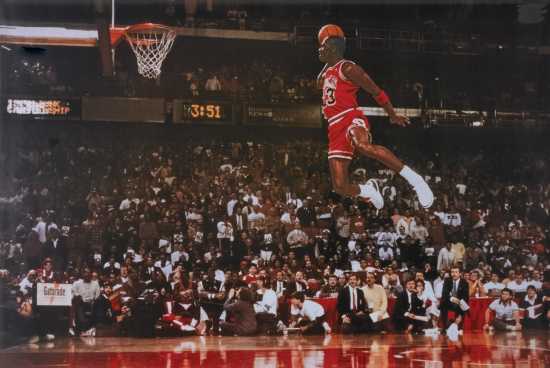
But what does it matter? With what real and official data regarding vertical running Do we count on Jordan? Unfortunately your most recent measurement is not the Combine of the NBA, since he did not participate in it, so we must go back to his university years where he already tasted the taste of triumph: North Carolina.
There, with the Jump Tester piggyback, Jordan reached 42 inches in the standing upright and 45,76″ in the vertical running, sweeping beforehand any subsequent record in the Combine of the NBA.
Was he able to surpass this mark in any of his hammer shots at the rim in his first decade of physical clarity in the NBA? Not at all disposable.
In the 90s everyone wanted to be like Mike but, above all, they wanted to crush like Mike. But how did Mike train? Well, he already said before that there is a lot of gift from God in this. Genetic inheritance that, like Usain Bolt's stride or Freddie Mercury's ventricular chords, cannot be ordered on Ebay.
PDFs, sessions and plyometric exercise routines fill the Internet these days, guaranteeing us to make our jumping potential profitable. In the early nineties, where effectiveness did not require accounts premium, Mike had no problem revealing the formula of his truth:
"The things I did to improve my jumping ability were very basic... I rode a bike, I worked on my jumping and my dunks, and I guess if you exercise the muscles related to the activity you are going to do, you end up improving..."
Michael Jordan.
Well, not!? With this it is clear to you that if you do not touch the net of the ring or its lower part it is because you do not feel like doing it. Folding stationary bike (which is a luxury in quarantine), now.
Next.
Air Canada
Michael had an airline, but Vince was given an entire country.
The successor, the heir, the witness... even the magazine of ESPN, in its December 1999 issue, gave the cover to Vinsanity with a single word in psychedelic purple: 'NEXT', in clear allusion to a Jordan whose nostalgia, after his retirement, skyrocketed fiercely and immediately.

Carter never reached the standards of those with whom, in his beginnings, he was tried to be compared—nothing to be ashamed of, on the other hand—except, possibly, in his daily, superb and anti-earthly pastime of challenging the world in Heights.
Among his merits in the panormana dunker, we must thank Vince, among other things, for having resurrected a dying contest, twisting the halo of Frédéric Weis (2,18) or showing us, at 38, that Andrew Wiggins' jumps are not as much as they seem.
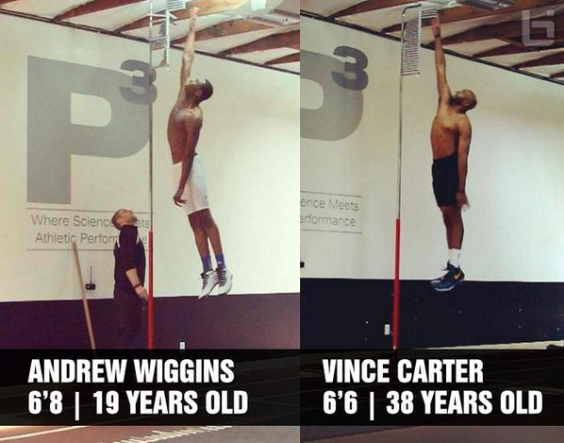
The most audacious claim that in his heyday Vince was able to reach around 50. Exaggerated. But, like Jordan, everything indicates that he had peaks in which, more than once and in the heat of the games, he had to surpass his mark (43 ») of the Combine.
Half man, half amazing to droneand. Neat, aesthetic, genuine, unstoppable. The mate made canvas with non-transferable copyright rights.
Zion: exaggeration or reality?
And now it's time, finally, for the League's gunpowder and spark for this article, and also in charge of coloring it with a few drops of present. Zion Williamson, the real one The Manimal and for whom I advocate a summary expropriation of Kenneth Faried's nickname.
Williamson, worthy cover photo of this post not only because of what he flies, but also because of what he lifts. To himself. 130 kilos. Most here not even two reps on deadlifts. He, with his steel glasses, looks down at the orange basket.
How much did you jump in the Combine? Zero. He didn't jump, like most lottery picks of his litter. It's a shame that it's starting to become fashionable (those who know picks older people tend to see going to these tests as a risk). But nothing serious as far as this is concerned: once again, the NCAA gives us the answer.
"My man, Zion Williamson, just broke Duke's record," is how RJ Barret claimed his teammate after the physical tests for Duke Blue Planet. "It's really fun to watch him jump."
Let's remember: 6,7 (2,01; three centimeters taller than Jordan and Carter) and 285 pounds (130 kg… about 30 more than the other two).
With these notes, the real question that would make sense to ask ourselves is: How much would it be able to take flight if it weighed around those –typical– one hundred?
In Jared Dubin's NBA database (a gem in which to get lost for hours), we can observe the marks achieved in the main tests of each prospect (who attended Combine, of course) between the years 2000 and 2019.
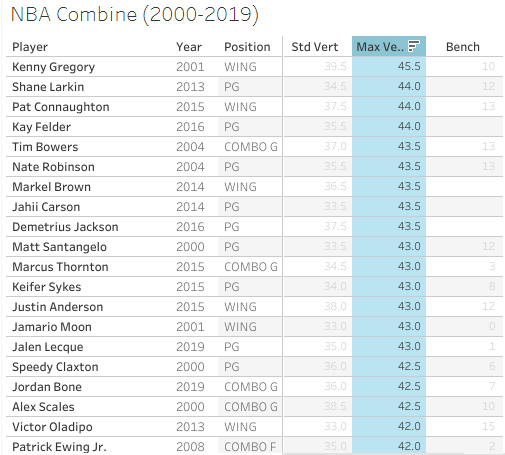
Duke coach Mike Krzyzewski He assured that Williamson had just broken the best record in the team's history from his university, with 45” (114 centimeters). And if we follow Coach K's statements (which I do), the now NOLA player would be the first NBA player to align himself with the 45" barrier so far in the XNUMXst century.
Let's take another couple of body references to finish delving into the caliber of nonsense: two enormously armored and explosive players in their first decade in the NBA:
- Blake Griffin (2,06 and 112 kilos).
- Dwight Howard (2,11 and 108 kilos).
These two, although taller, are not only lighter than Duke's bug, but they jump 10 inches less than it (35,5").
In fact, the only player in the entire database who currently has his neck ahead of Williamson's is Kenny Gregory, formerly of Kansas. His weight, however, was 38 kilos less!, and he barely jumped an centimeter more than the forward of the Pelicans.
The Chamberlain Myth
And we close this study with a penetrating look at the past.
'Wilt the Stilt', 'Goliath', and his favorite, 'The Big Dipper' (because he had to 'submerge' his head to avoid hitting it when passing through doors) were some of the nicknames that They accompanied Wilt Chamberlain during his extensive reign, and they serve as a prologue so that any layman who does not know his legend, knows from the outset that we are not exactly dealing with a 'short madman' of those of today.
The most dominant player in black and white history. The titan of 100 points. The one that distorts any historical record and forces the asterisk on those of us who dare to include it in the curve. Everything was huge in Wilt. Maybe even his bragging.
«The mistake is that most people consider that great jumpers are only short guys capable of dunking. My sergeant [standing vertical] was superior to that of Michael Jordan. When I went to Kansas, they had a 12-foot basket in the gym, a request from Dr. Phog Allen. He used to dunk it in that basket. With effort, but I could do it.
Wilt Chamberlain.
These are words from Wilt himself years after retiring, in which the vindication and a certain dose of rage do not go unnoticed.
As the four-time MVP points out, the very big men They are rarely recognized as great jumpers, since if they score high above the rim it is because they are tall. This is how the popular assumption works.
But Wilt was a rara avis. Tall (2,16), big, strong, but also very agile and with very powerful shins. So much so that there are multiple voices and blogs full of threads that claim that he could reach 48”… something that Wilt, comfortable in the vast legend of him, never bothered to deny.
So, with your permission, I will now adopt the role of skeptical and picky lawyer, starting by clarifying a couple of things.
First, it is almost impossible to distinguish the exact height of a jump from an old videotape. The angle of the cameras is deceptive, and in the videos of the 60s, with diagonal and high shots – and without an additional plane with which to compare or collate – even more so.
The second is the natural reflection of the evolutionary chronology. Olympic records fall one after another edition after edition. Even the most 'unbreakable' ones barely last two decades. And as with every rule, there is an exception. Bob Beamon and his aliens 8,90 meters in the long jump, achieved at the 1968 Olympic Games in Mexico, survive as a record that half a century later remains unparalleled.
But today, if we pour into the same flask genetic adaptation, medical advances, physical methodism and the professionalization of sport that supports a refinement and maximization of potential like never before... is it coherent to think that Wilt resists, as unbreakable? Cro-Magnon vestige,… also in this?
Good faith is one thing and naivety another. Based on his 2,16 height from the ground, to talk about a jump of 46 inches (the maximum height popularly given to Jordan), Chamberlain should be able to kiss the rim with his lips; The 48″ would even allow for a bite in the neck area… and in the video evidence we have (the only solid plausible evidence) he barely exceeds it with the crown of his head.
"It practically touched the highest end of the board!" some cry. Something not so heroic to be like this (there are no images of it either), taking into account his supernatural size (2,36 meters), only surpassed in the history of the League by a player who was already famous for his tremendous merlu skewers, even more rose to fame for being the first NBA victim (now happily recovered) of the coronavirus: Rudy Gobert and his 2,38 meters.
With the data in hand and the relevant calculations, a jump of 44” (already colossal) would be enough for Wilt to clean the cobwebs off the board with his hand.
Space Jams
During my early childhood, and due to an English that was caught on pins and needles, I always thought that the title of sci-fi starring Jordan was Space Jam (was it so difficult to call it Space Dunk or Space Slam?), until, already in my teens, I learned that, in its meaning three thousand forty-seven, it also meant, in basketball jargon, mate.
And without being space mates (which are special), the ones we have named plus some below, do give off an extraterrestrial aroma when it comes to bursting the ring. Gigantic propulsions in slow-mo, where time stops and the viewer is amazed.
This list, inspired by previous attempts by The Excercisers y Home Exercise Equipment Central and redesigned after my own investigations, it deserves a very relative reliability, since you have already been able to see how dense the fog is when it comes to rescuing unofficial measurements.
Not all of them are there, but I do intend for them to be all of them. Iconic players with NBA past or present, whose presence in this classification may be of interest to you.
≥45
- Michael Jordan 46»
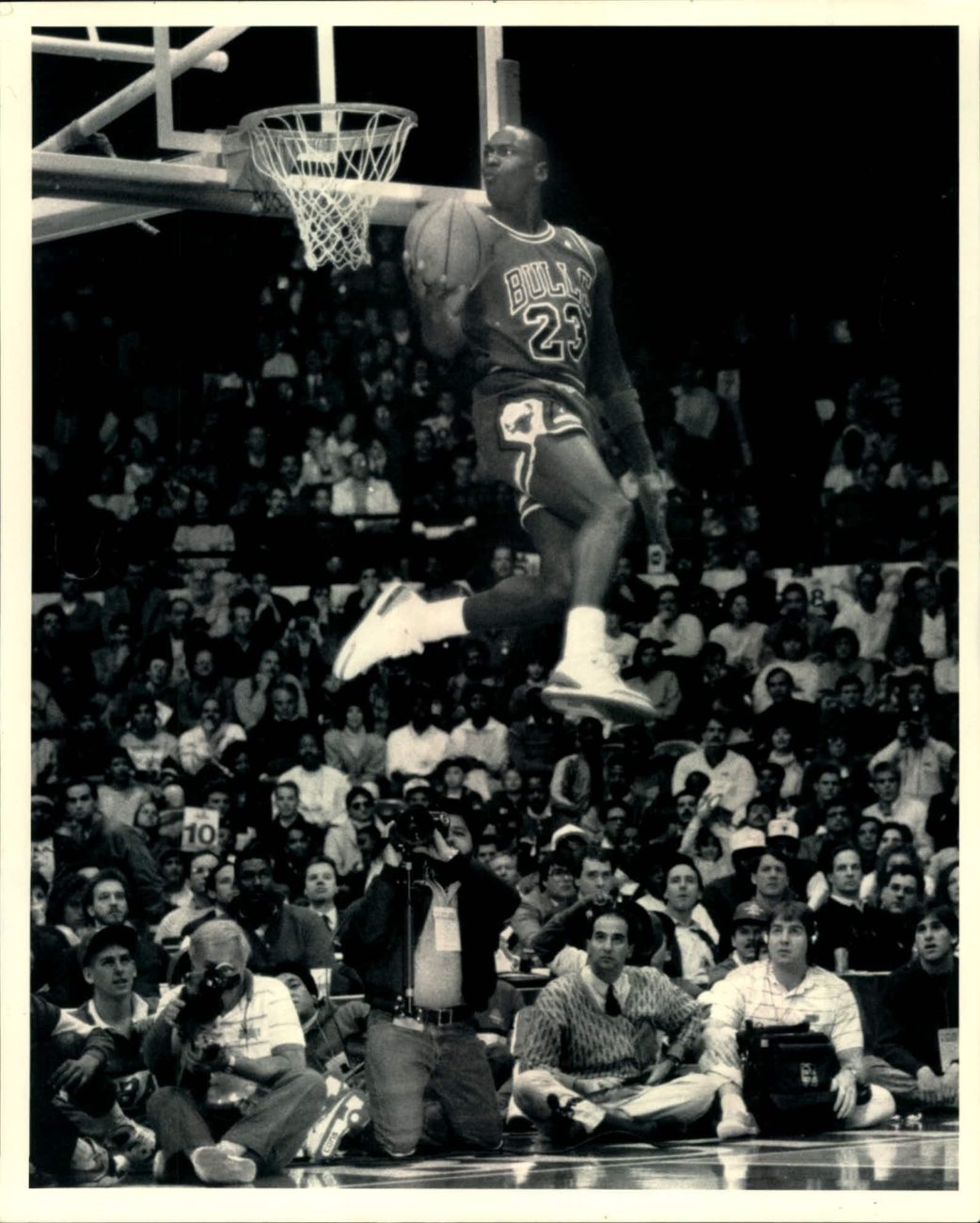
- DJ Stephens 46″
- Kenny Gregory 45,5»
- *Zion Williamson 45″
- *Dennis Smith Jr. 45″ (he claims to have reached 48″…)
≥44
- Vince Carter 44,5″
- Darrell 'Dunkenstein' Griffith 44'5″
- James White 44,5»
- Jason Richardson 44,5″
- Shanon Brown 44,5″
- Hamidou Diallo 44,5»
- Spudd Webb 44,5″
- David 'Skywalker' Thompson 44,5»
- Muggsy Bogues «44,3» (curiosity: he never dunked in the NBA)
- Andrew Wiggins 44»
- Shane Larkin 44»
- Pat Connaughton 44»
- LeBron James 44»
- Dee Brown 44″
≥43
- Nate Robinson 43,5»
- Wilt Chamberlain 43,5»
- Markel Brown 43,5″
- Julius Erving (Dr. J) 43»
- Zach LaVine 43″ (he signed a 'poor' 41,5" at the Combine)
- Jamario Moon 43″
- Harold Miner 43»
- Justin Anderson 43″
- Derrick Jones Jr. 43″ (42,5″ in 2015 by Draft Express)
≥42
- Tracy McGrady 42,5″
- Gerald Green 42″ (unexplained 39″ in the Combine)
- Clyde Drexler 42″
- Dominique Wilkins 42″
- Victor Oladipo 42″
- Magnet Shumpert 42″
- Steve Francis 42»
≥41
- Matt Barnes 41,5″
- Shawn Kemp 41″
- Allen Iverson 41″
≥40
- Miles Plumlee 40,5″ (second big man in exceeding 40″)
- Derrick Rose 40,5″
- Nick Young 40,5″
- Eric Bledsoe 40″
≥39
- Aaron Gordon 39,5″
- Harrison Barnes 39,5″
≥38
- DeMar DeRozan 38,5″
- Kobe Bryant 38″
- Russell Westbrook 38″
≤37
- James Harden 37”
- Dwight Howard 35,5”
- Blake Griffin 35,5″
- Kevin Durant 33,5″
- ...
- DeAndre Jordan 31,5”
- ...
- ...
- ...
- DeMarcus Cousins 27,5″
- Nikola Vucevic 25″
- 👀👋🏽👋🏽
Sources: NBA Stats, Real GM, Jospt.org, Hoops Beast, The Exercisers, Vertical Jump World, Home Excercise Equipment Central, The Hoops Geek, Quora, LA Times and 247 Sports
(Cover photo by Grant Halverson/Getty Images)
This text It was published yesterday, Sunday, April 12 in Extra nbamaniacs for all subscribers. We need you to continue creating content like this and others that we usually write and also to be able to do it without depending on advertising. Support us. Subscribe to Extra nbamaniacs.
